
myCBSEguide App
Download the app to get CBSE Sample Papers 2023-24, NCERT Solutions (Revised), Most Important Questions, Previous Year Question Bank, Mock Tests, and Detailed Notes.
Install NowSexual Reproduction in Flowering Plants Class 12 Notes Biology in PDF are available for free download in myCBSEguide mobile app. The best app for CBSE students now provides Sexual Reproduction in Flowering Plants class 12 Notes latest chapter wise notes for quick preparation of CBSE board exams and school-based annual examinations. Class 12 Biology notes on chapter 2 Sexual Reproduction in Flowering Plants are also available for download in CBSE Guide website.
Revision Notes of Class 12 Biology Chapter 2 Sexual Reproduction in Flowering Plants
Download CBSE class 12th revision notes for chapter 2 Sexual Reproduction in Flowering Plants in PDF format for free. Download revision notes for Sexual Reproduction in Flowering Plants class 12 Notes and score high in exams. These are the Sexual Reproduction in Flowering Plants class 12 Notes prepared by team of expert teachers. The revision notes help you revise the whole chapter 2 in minutes. Revision notes in exam days is one of the best tips recommended by teachers during exam days.
Download Revision Notes as PDF
Class 12 Notes For Sexual Reproduction in Flowering Plants
Reproduction ensures continuity of species generation after generations as the older individuals undergo senescence and die. Flowering plants shows sexual mode of reproduction and bears complex reproductive units as male and female reproductive units along with accessary structures.
Flower is a modified stem which functions as a reproductive organ and produces ova and/or pollen. A typical angiospermic flower consists of four whorls of floral appendages attached on the receptacle: calyx, corolla, androecium (male reproductive organ consisting of stamens) and gynoecium (composed of ovary, style and stigma) .
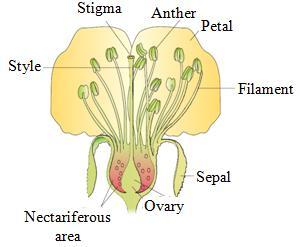
Pre-fertilisation: Structures and Events
• Several structural and hormonal changes lead to formation and development of the floral primordium. Inflorescence is formed that bears floral buds and then flower.
• In flowers, male (androecium) and female (gynoecium) differentiate and develops in which male and female gametes are produced.
Stamen, Microsporangium and Pollen Grain :
• Stamen consists of long and slender stalk called filament and generally bilobed anthers. Each lobe contains two theca (dithecious).
• The anther is four-sided structure consisting of four microsporangia, two in each lobes.
• Microsporangia develop further and become pollen sacs which contain pollen grains.
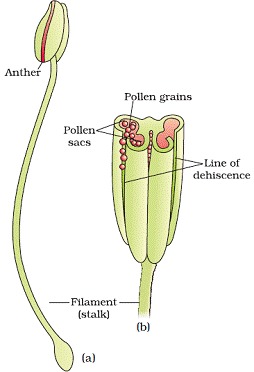
• Microsporangium is generally surrounded by four layered walls- the epidermis, endothecium, middle layer and tapetum. Innermost layer tapetum nourishes the developing pollen grains.
• Sporogenous tissues- It is compactly arranged homogenous cells which are present at centre of each microsporangium when the anther is young..
Microsporogenesis- The process of the formation and differentiation of microspores (pollen grains) from microspore mother cells (MMC) by reductional division is called microsporogenesis.
• The cells of sporogenous tissues undergo meiotic division to form microspore tetrad. As the anther mature and dehydrate, the microspore dissociate and develops into pollen grains.
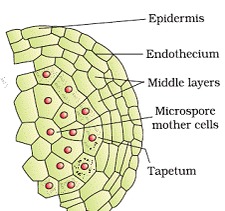
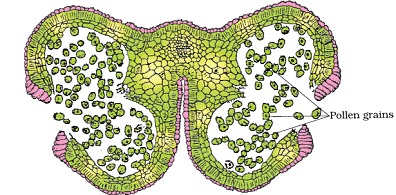
Pollen grain represents the male gametophytes. Pollen grains are made of 2 layered Wall,
1. Exine :- Made of sporopollenin- most resistant organic matter known.It can withstand high temperatures and strong acids and alkali. No enzyme can degrade sporopollenin
2. Intine :-
-Thin and continuous layer
– Made of cellulose and pectin
3. Germ pores
– apertures on exine where sporopollenin is absent
– forms pollen tube.
4. A plasma membrane surrounds cytoplasm of pollen grain.
MATURE POLLEN
— A mature pollen consist of 2 cells with nucleus (Vegetative and Generative)
VEGETATIVE CELL
- Bigger
- Abundant food reserve
- Large irregular nucleus
- Responsible for the development of pollen grain
GENERATIVE CELL
- Small
- Involves in syngamy (fuse with an egg)
- Dense cytoplasm and nucleus
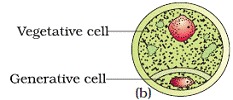
- Pollen grains of many species e.g Parthenium cause severe allergies and bronchial diseases in some people and leads to chronic respiratory disorders– asthma, bronchitis, etc.
• Pollen grains are rich in nutrients and are used as pollen tablets as food supplements.
• Viability of pollen grain varies with species to species and should land on stigma before this period to germinate. Pollen grains of large number of species are stored in liquid nitrogen at temperature – 1960, called pollen bank.
The Pistil, Megasporangium (Ovule) and Embryo sac
• Gynoecium may consists of single pistil (monocarpellary) or more than one pistil (polycarpellary) which may be fused (syncarpous) or free (apocarpous).
e.g Multicarpellary and syncarpous pistil- Papaver
Multicarpellary and apocarpous pistil- Michelia
• Each pistil has three parts the stigma, style and ovary. Inside the ovary is ovarian cavity (locule). The placenta is located inside the ovarian cavity. Megasporangia (ovules) arise from placenta.
Megasporangium (ovule)
- Ovule is a small structure attached to placenta.
- Funicle – stalk by which ovule is attached to placenta
- Hilum- junction between ovule and funicle
- Integuments- protective envelops
- Micropyle- small opening at the tip of ovule into where pollen tube enters
- Chalaza- basal part of ovule
- Nucellus (2n)-mass of cells enclosed in integuments. Has abundant food reserve.
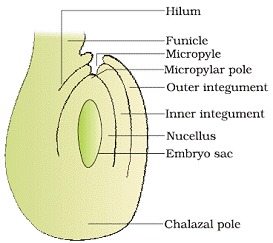
Megasporogenesis- The process of formation of megaspore from megaspore mother cell by meiotic division is known as megasporogenesis. This process takes place in ovule
Ovule differentiates a single megaspore mother cell (MMC) in the micropylar region of nucellus. MMC undergoes meiotic division that results into the production of four megaspores.
• In most of the flowering plants three megaspores degenerate. 1megaspore develops into female gametophyte (embryo sac).
• The nucleus of functional megaspore divides mitotically to form two nuclei which move to opposite poles to form 2-nucleate embryo sac. Two more sequential mitotic division results into 8-nucleate embryo sac.
• Six of the eight nuclei surrounded by cell wall and remaining two nuclei (polar nuclei) are situated below the egg apparatus.
• Three cells are grouped at micropylar end to constitute egg apparatus and three cells at chalazal end forms antipodal cells. At maturity ,embryosac is 8-nucleate and 7 celled.
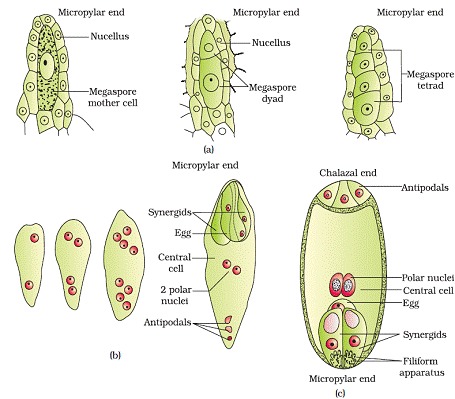
Pollination – transfer of pollen grains from anther to stigma.
a) Autogamy– transfer of pollen grain from anther to stigma of same flower.
i. Cleistogamous – flower which do not open. cleistogamous flowers are autogamous as there is no chance of cross-pollen landing on the stigma. Cleistogamous flowers produce assured seed-set even in the absence of pollinators. e.g Viola (common pansy), Oxalis, and Commelina.
ii. Chasmogamous– exposed anther and stigma.
b) Geitonogamy – transfer of pollen grains from anther to stigma of different flower of same plant. Geitonogamy is functionally cross-pollination involving a pollinating agent, genetically it is similar to autogamy since the pollen grains come from the same plant
c) Xenogamy– transfer of pollen grain from anther to stigma of different plant’s flower of same species.
Agents of pollination includes abiotic (water, wind) and biotic (insects, butterfly, honey bee etc. large number of pollen grains are produced by plants using abiotic mode of pollination as most of pollen grains are wasted during transfer.
Adaptations in flowers for Pollination
I. Wind Pollination
- pollen grains :– light, non- sticky, winged
- anther :- well exposed
- stigma :- large and feathery
- flower :- one ovule, arranged as inflorescence
Ex : corn cob, cotton, date palm
II. Water Pollination
– Bryophytes, Pteridophytes, Algae
- pollen grains : protected by mucilaginous covering
Ex : Fresh water plants- Vallisneria, Hydrilla
Sea grass- Zostera
Main features of wind and water pollinated plants
– produce pollen grains in large no.
– do not produce nectar
III. Insect Pollination
– Flowers : large, colourful, fragrant, rich in nectar
– Pollen grains : sticky
– Stigma : sticky
Certain rewards to pollinators:
- nectar and (edible) pollen grains as foods
- provide safe place for laying eggs
Ex : Amorphophallus, Yucca
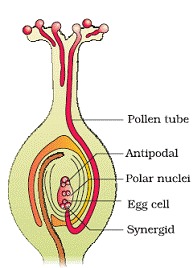
Outbreeding Devices– the various mechanisms take discourage self-pollination and encourage cross pollination as continued self-pollination leads to inbreeding depression. It includes
• Pollen release and stigma receptivity not synchronized.
• Anther and stigma are placed at different position.
• Inhibiting pollen germination in pistil.
• Production of unisexual flowers.
Pollen pistil interaction – the pistil has ability to recognize the compatible pollen to initiate post pollination events that leads to fertilisation. Pollen grain produce pollen tube through germ pores to facilitate transfer of male gametes to embryo sac.
Artificial Hybridization
- Crossing diff varieties of species- hybrid individual- with desirable characters of the parent plants
- desired pollen grains for pollination- stigma protected from contamination
- Emasculation : removal of anther
- Bagging : flower covered- bag made up of butter-prevent contamination of stigma from unwanted pollen
Bagged flower- attains receptivity- mature pollen grains- dusted on the stigma – rebagged- fruits allowed to develop
Double Fertilisation- after entering the one of the synergids, each pollen grain releases two male gametes. One male gametes fuse with egg (Syngamy) and other male gametes fuse with two polar nuclei (triple fusion) to produce triploid primary endosperm nucleus (PEN). Since two types of fusion takes place in an embryo sac the phenomenon is called double fertilisation. The PEN develops into the endosperm and zygote develops into embryo.
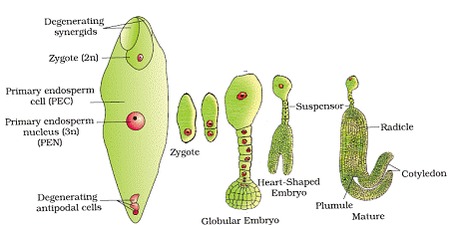
Post fertilisation events include endosperm and embryo development, maturation of ovules into seeds and ovary into fruits.
Endosperm– the primary endosperm cell divides many time to forms triploid endosperm tissue having reserve food materials.
Two types of endosperm development :
(i) Free nuclear type (common method)
(ii) Cellular type
(a) Non-albuminous- endosperm completely utilized- before maturation of seeds. e.g pea, groundnut
(b) Albuminous- a portion of endosperm remain in mature seeds. e.g wheat, maize, castor
Embryo- Embryo develops at the micropylar end of the embryo sac where the zygote is located.
Embryogeny – early stages of embryo development.The zygote gives rise to the proembryo and subsequently to the globular, heart-shaped and mature embryo.
Embryo consists of:
– embryonal axis
– cotyledons
– plumule
– radicle
Monocotyledonous Seed
– Scutellem = Cotyledon
– Coleorrhiza: undifferentiated sheath covering radical & root cap
– Coleoptile: sheath covering plumule
Seed
– Fertilized and mature ovule develops into seed.
Seed consists of:
– cotyledon(s)
– embryonal axis
– Seed coat- double layered- formed by integuments
- Testa (outer coat)
- Tegmen (inner coat)
– Micropyle:- small opening on seed coat, it facilitates entry of H2O & O2 into seeds (for germination)
– Hilum:- scar on seed coat
– Seed – Albuminous / Non-Albuminous
– Perisperm : remnants of nucellus that is persistent. Ex: Black pepper
– Dormancy: state of inactivity
• The wall of ovary develops into wall of fruit called pericarp. In true fruits only ovary contributes in fruit formation by in false fruit thalamus also contributes in fruit formation.
Apomixis
– Form of asexual reproduction- mimics sexual reproduction- seed formed without fertilisation
– Formation of apomictic seeds :
• diploid cell (formed without meiosis)- develop into embryo without fertilization
• cells of nucellus (2n) surrounding embryo sac- protrude into embryo sac- develop into embryos. Ex. Citrus and Mango.
Polyembryony
– Occurrence of more than one embryo in a seed
– Often associated with apomixes. Ex: Citrus, groundnut
Revision Notes Class 12 Biology – Free PDF Download
CBSE quick revision note for class-12 Chemistry Physics Math’s, Biology and other subject are very helpful to revise the whole syllabus during exam days. The revision notes covers all important formulas and concepts given in the chapter. Even if you wish to have an overview of a chapter, quick revision notes are here to do if for you. These notes will certainly save your time during stressful exam days.
- Physics
- Chemistry
- Mathematics
- Biology
- Accountancy
- Economics
- Business Studies
- Computer Science
- Informatics Practices
- English Core
- History
- Physical Education
To download Sexual Reproduction in Flowering Plants class 12 Notes Biology, sample paper for class 12 Physics, Chemistry, Biology, History, Political Science, Economics, Geography, Computer Science, Home Science, Accountancy, Business Studies, and Home Science; do check myCBSEguide app or website. myCBSEguide provides sample papers with solution, test papers for chapter-wise practice, NCERT Sexual Reproduction in Flowering Plants, NCERT Exemplar Sexual Reproduction in Flowering Plants, quick revision notes for ready reference, CBSE guess papers and CBSE important question papers. Sample Paper all are made available through the best app for CBSE students and myCBSEguide website.

Test Generator
Create question paper PDF and online tests with your own name & logo in minutes.
Create Now
myCBSEguide
Question Bank, Mock Tests, Exam Papers, NCERT Solutions, Sample Papers, Notes
Install Now
Thank you so much this notes are very helpful
Thank you soooooo much My CBSE guide
This notes very helpful and easy way to understand
thankyou ‘my cbse guide’ for these notes. they are very understanding and helpful.
Thanks for providing such a nice note it is very helpful ??
Thanks for providing such a nice note it is very helpful for me ??
good work
It’s good for understanding the syllabus of bio
Good notes
thankyou ‘my cbse guide’ for these notes. they are very understanding and helpful.
Your notes are helping me a lot, Thank U So Much My CBSE guide ?
after reading this notes i done my all question in exam. this notes is very useful for neet aspirants.
This is very helpful for me
Thank you so much
Thank you for a good notes …it’s really help me to learn quick go fast …now onward I will be prepare for this ??
Tumhare maa ki bhosadi pdf dena hai to do nahi to gaad marao sinup nahi karenge
Nice work ?
And explain explain nation
Of notes ? and
Chapter
Yes I understood everything ?… Thanks
It was helpful ?
Thank you so much for providing these notes these are really helpful and easy to write.
Thank you so much ???
nice notes
????? ???? ???
Really very nice notes.
I only came to write notes just because of copy complition although they are good notes ??
Nice notes
This is very easy and appreciated notes… Thank you so much my cbse guide
Ahh.. finally completed ? thanks for the notes??
Very help full notice